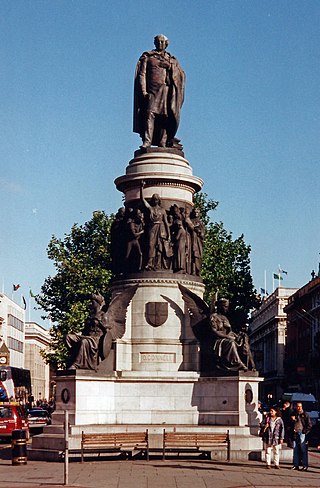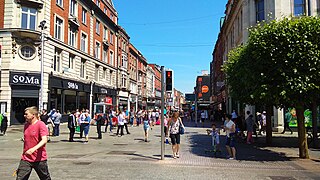
O'Connell Street is a street in the centre of Dublin, Ireland, running north from the River Liffey. It connects the O'Connell Bridge to the south with Parnell Street to the north and is roughly split into two sections bisected by Henry Street. The Luas tram system runs along the street.

The Spire of Dublin, alternatively titled the Monument of Light, is a large, stainless steel, pin-like monument 120 metres (390 ft) in height, located on the site of the former Nelson's Pillar on O'Connell Street, the main thoroughfare of Dublin, Ireland.

Georgian Dublin is a phrase used in terms of the history of Dublin that has two interwoven meanings:
- to describe a historic period in the development of the city of Dublin, Ireland, from 1714 to the death in 1830 of King George IV. During this period, the reign of the four Georges, hence the word Georgian, covers a particular and unified style, derived from Palladian Architecture, which was used in erecting public and private buildings
- to describe the modern day surviving buildings in Dublin erected in that period and which share that architectural style

Ballymun is an outer suburb of Dublin, Ireland, at the northern edge of the Northside, the green-field development of which began in the 1960s to accommodate a housing crisis in inner city areas of Dublin. While the newly built housing was state-of-the-art at the time, comprising high-rise tower blocks and flat complexes, residents were moved in years before shops, schools and other infrastructure were fully ready, and the area became well known for both a strong community spirit and considerable social challenges. Ballymun has several sub-districts such as Sillogue, Coultry, Shangan and Poppintree, and is close to both the Republic of Ireland's only IKEA store and to Dublin Airport. The area is the source of one Dublin river, and parts lie in the floodplain of another, and there are a number of parks.

St Stephen's Green is a garden square and public park located in the city centre of Dublin, Ireland. The current landscape of the park was designed by William Sheppard. It was officially re-opened to the public on Tuesday, 27 July 1880 by Lord Ardilaun. The square is adjacent to one of Dublin's main shopping streets, Grafton Street, and to a shopping centre named after it, while on its surrounding streets are the offices of a number of public bodies as well as a stop on one of Dublin's Luas tram lines. It is often informally called Stephen's Green. At 22 acres (8.9 ha), it is the largest of the parks in Dublin's main Georgian garden squares. Others include nearby Merrion Square and Fitzwilliam Square.

Saint Fin Barre's Cathedral is a Gothic Revival three-spire Church of Ireland cathedral in the city of Cork. It is located on the south bank of the River Lee and dedicated to Finbarr of Cork, patron saint of the city. Formerly the sole cathedral of the Diocese of Cork, it is now one of three co-cathedrals in the United Dioceses of Cork, Cloyne and Ross in the ecclesiastical province of Dublin. Christian use of the site dates back 7th-century AD when, according to local lore, Finbarr of Cork founded a monastery. The original building survived until the 12th century, when it either fell into disuse or was destroyed during the Norman invasion of Ireland. Around 1536, during the Protestant Reformation, the cathedral became part of the established church, later known as the Church of Ireland. The previous building was constructed in the 1730s, but was widely regarded as plain and featureless.

Dublin is one of the oldest capital cities in Europe – dating back over a thousand years. Over the centuries and particularly in the 18th century or Georgian era, it acquired a distinctive style of architecture. Since the 1960s, Dublin has been extensively re-developed, sometimes resulting in the replacement of earlier buildings. Some of this has been controversial with preservationists regarding the development as unwelcome.

Frescati House was a Georgian house and estate situated in Blackrock, Dublin. It was built in 1739 for the family of John Hely Hutchinson, the Provost of Trinity College.

Molesworth Street is a street in Dublin, Ireland named after Richard Molesworth, 3rd Viscount Molesworth and links the more notable Dawson Street with Kildare Street and lies just over 200 m to the north of St. Stephens Green in Dublin's central business district.

Moore Street is a street in central Dublin, Ireland, off Henry Street, one of Ireland's main shopping streets. The famous Moore Street open-air fruit and vegetable market is Dublin's oldest food market. The market there is a famous landmark on the northside of the city.

Britain Quay is a street and quay in Dublin on the south bank of the River Liffey between Sir John Rogerson's Quay and the confluence of the River Liffey, River Dodder and Grand Canal.

Hume Street is a street in central Dublin located between Ely Place and St. Stephen's Green. It is named after Sir Gustavus Hume, 3rd Baronet (c.1670–1731) and his family.

Talbot Mall was a small shopping arcade located between Talbot Street, Northumberland Square, and Abbey Street in Dublin, Ireland. Operating for some years with only a few trading units, it latterly primarily formed a public passage between Talbot and Abbey Streets. As of 2021, permission was granted for a development which would replace the mall with a single supermarket and close the public passage between the streets, and this proceeded in 2022.

Aldborough House is a large Georgian house in Dublin, Ireland. Built as a private residence by 1795, the original structure included a chapel and a theatre wing.

North Earl Street is a short stretch of city-centre street located on Dublin's Northside and formerly a major shopping area. It runs from Marlborough Street in the west to O'Connell Street beside the Spire.
The Carlton Inn was a former pub in Carlton, Melbourne, in the Australian state of Victoria. Built c. 1856, it was controversially illegally demolished without planning or heritage approval on the weekend of 15–16 October 2016. Before demolition, it was one of the oldest buildings in the Carlton area. In its last years, it was known as the Corkman Irish Pub.

Hawkins House was a 12-storey office block in Dublin, Ireland. It was demolished in 2021.

Fenian Street is a street in Dublin, Ireland.

Cuffe Street is a street in Dublin, Ireland which runs from St Stephen's Green at the eastern end to Kevin Street Lower at the western end.
Boyne Street is a street in Dublin, Ireland.



















